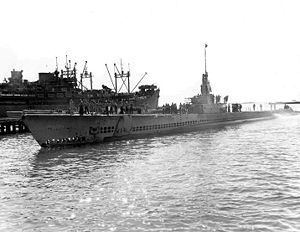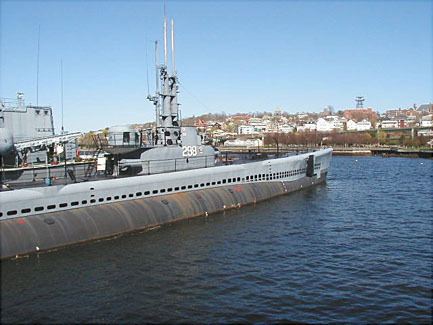Name Lionfish Laid down 15 December 1942 Commissioned 1 November 1944 Construction started 15 December 1942 Length 95 m Year built 1943 | Namesake Lionfish Sponsored by Mrs. Harold C. Train Decommissioned 16 January 1946 Launched 7 November 1943 Area 809.4 m² Builder William Cramp & Sons | |
 | ||
Similar USS Becuna, USS Razorback (SS‑394), USS Batfish, USS Joseph P Kennedy, USS Clamagore (SS‑343) | ||
USS Lionfish (SS-298), a Balao-class submarine, was the only ship of the United States Navy named for the lionfish, a scorpaenid fish native to the Pacific and an invasive species found around the Caribbean. She was designated a National Historic Landmark in 1986, and is now on display at Battleship Cove in Fall River, Massachusetts.
Contents

History

Lionfish was laid down on 15 December 1942; launched on 7 November 1943, sponsored by Mrs. Harold C. Train; and commissioned on 1 November 1944. Her first captain was Lieutenant Commander Edward D. Spruance, son of World War II admiral Raymond Spruance.
World War II

After completing her shakedown cruise off New England, she began her first war patrol in Japanese waters on 1 April 1945. Ten days later, she avoided two torpedoes fired by a Japanese submarine. On 1 May Lionfish destroyed a Japanese schooner with her deck guns. After a rendezvous with the submarine USS Ray, she transported B-29 survivors to Saipan and then made her way to Midway Island for replenishment.

On 2 June she started her second war patrol, and on 10 July fired torpedoes at a surfaced Japanese submarine, after which Lionfish's crew heard explosions and observed smoke through their periscope (the Submarine I-162 was undamaged). She subsequently fired on two more Japanese submarines. Lionfish ended her second and last war patrol performing lifeguard duty (the rescue of downed fliers) off the coast of Japan. When World War II ended on 15 August she headed for San Francisco and was decommissioned at Mare Island Navy Yard on 16 January 1946.
Post World War II
Lionfish was recommissioned on 31 January 1951, and headed for the East Coast for training cruises. After participating in NATO exercises and a Mediterranean cruise, she returned to the East Coast and was decommissioned at the Boston Navy Yard on 15 December 1953.
In 1960, the submarine was placed in service, but not recommissioned, as a reserve training submarine at Providence, Rhode Island.
Museum ship
In 1971, she was stricken from the Navy Register. In 1973, she began permanent display as a memorial at Battleship Cove in Fall River, Massachusetts, where she is one of the museum's most popular exhibits.
As Lionfish was never converted to a GUPPY configuration, she is one of the very few preserved American World War II-era submarines in her "as built" configuration. Because of this remarkable state of preservation, she was designated a National Historic Landmark in 1986.
In popular culture
The submarine is featured on the DVD case of the 2007 Ubisoft game Silent Hunter 4: Wolves of the Pacific.
Lionfish served as a filming location for the film Subconscious, in which the submarine portrays a fictional version of itself in a supernatural/science-fiction plotline taking place in both the years 1943 and 2014.
